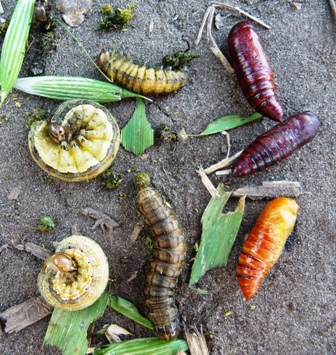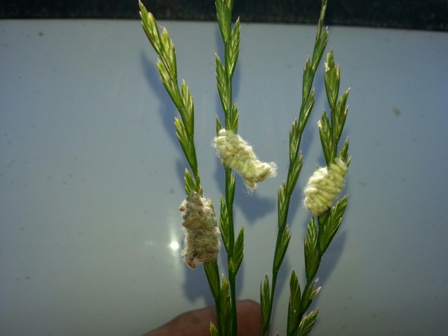Manitoba Insect & Disease Update: July 14, 2015
Armyworms: Armyworms continue to be found in many cereal fields. In many fields they are noticeable but not economical, however some fields have had levels greater than the 4 or more larvae/ft2 threshold and have been sprayed for armyworms. A few things to consider when finding armyworms:
How patchy are levels in a field: Economic thresholds are usually based on levels on average over the whole field. Armyworms can be very patchy in a field, and are usually much more abundant in lodged areas of the field. So if finding high levels in a lodged patch of crop, don't assume the whole field has those levels.
How close are they to finishing their crop feeding (larval) stage. The length of time spent as larvae varies with temperature. In studies where larvae were kept at a constant temperature, larval stages lasted 16 days at 29 degrees Celsius, 26 days at 21 degrees Celsius, and 40 days at 17 degrees Celsius. Based on our current weather, they should be going through their larval stages in somewhere around 3 weeks. Mature larvae are 3 to 3.5 cm long. Once larvae are nearing the end of their larval period, insecticide applications to above threshold populations would become less economical. In samples of armyworms collected in the Carman area, some of the larvae are now turning to pupae. The photo below shows various stages of armyworms. The pupae (on the right in the photo) would normally be in the soil, but were exposed to show them next to the larvae. The smaller larva at the top of the photo is actually at a more advanced stage than the larvae below it. The armyworm caterpillars feed for the first part of their last larval stage, then stop feeding, become quite inactive and will shrink somewhat before turning in to a pupa. You may come across some of these and note that they move very little and don't curl up when you disturb them.

Figure 1. Various stages of armyworms.
Are their parasitoids of armyworms present. Quite a few people over the past week have sent in photos (as in Figure 2 below) asking what are these "eggs" on the cereal heads, and noticing that they can be quite abundant in some fields. These are not eggs, but are the pupal cases of parasitic wasps. These are being found in fields that contained armyworms, and it is likely that armyworms were hosts for the parasitoids. For some parasitoids it is common for dozens of parasitoid larvae to emerge at the same time from an individual armyworm, killing it in the process. This is because an initial egg laid in the armyworm starts dividing and can become dozens or at times hundreds of eggs, that results in multiple parasitoid larvae of the same general age feeding in the armyworm. When the parasitoids emerge form the armyworm, they all emerge at approximately the same time, and very soon after form these clusters of pupal case, which are together in a cluster on the plants. So each cluster would have been parasitoids form a single armyworm, and will result in multiple wasps looking for more caterpillars to parasitize.

Figure 2. Pupal cases of a wasp parasitic to armyworms.
Photo from Dean McCowan, Agree Ag Services.
| Location | Region | Trap Count |
|---|---|---|
| Darlingford | Pembina | 192 |
| Alexander | Southwest | 173 |
| Inglis | South Parkland | 170 |
| Douglas | Southwest | 136 |
| Somerset | Pembina | 120 |
| Baldur | Pembina | 103 |
| Tourond | Eastman | 99 |
| Carberry | Central Plains | 92 |
John Gavloski, Entomologist
Manitoba Agriculture, Food and Rural Development
Phone: (204) 745-5668 Fax: (204) 745-5690.
To report observations on insects or plant pathogens that may be of interest or importance to farmers and agronomists in Manitoba, please send messages to the above contact address.
To be placed on an E-mail list so you will be notified immediately when new Manitoba Insect and Disease Updates are posted, please contact John Gavloski at the address or numbers listed above.
Manitoba Insect & Disease Update: July 14, 2015

